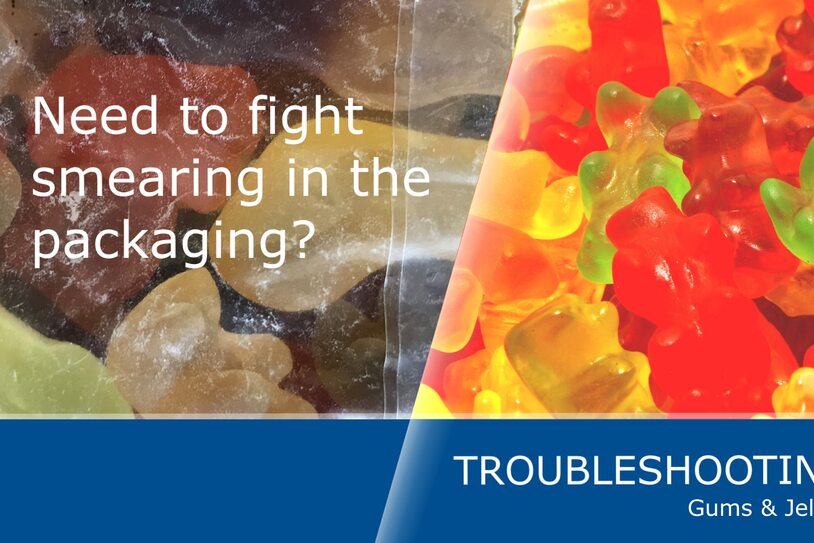Smeared packaging with gums and jellies can be complex and frustrating, especially since it only becomes visible at the end of a long process, in the finished packed product. While anti-sticking agents may appear to be the main driver, the true origin of the problem lies in the earlier stages of the production process.

Without a doubt, a white smeary film in the packaging of gums or jellies is a problem for the success of a candy brand. The uninviting look can turn out to be a showstopper at the point of sale. Though the smearing may not be initially related to the quality of the recipe and ingredients, the final appearance plays an important role in the overall perception of product quality. Often the finishing with anti-sticking agents comes under suspicion when issues with smearing appear, as it is the last step before packaging. However, confectioners must seek to remedy the causes of smearing in earlier stages of the production of their gums and jellies.
“Applying the right type of mogule starch is vital”, says Martins Zerwes, Senior Technical Sales Manager at CAPOL. The preferred starch is either corn starch or a mixture of wheat, corn and rice starch while potato starch is not recommended due to its tendency to cake or clump. Martins explains: “The setting of the gums is already a key process for perfectly finished gummies. Particular attention needs to be paid to the moisture content of the molding starch which should not deviate from a certain range.” If the moisture content is too low, the mogul starch will lose its ability to hold the shape of the moulds as it becomes dry and crumbly. A dustier mogule starch can also increase the explosion hazards in production. If on the other hand moisture levels of the mogule starch exceed the recommended range, it will become less effective as a curing aid for gums and jellies. The higher the moisture level when the slurry is deposited into the cast, the less the mogul starch will be able to absorb moisture from the gums or jellies during the curing phase. “Technically speaking, when the moisture level of the mogule starch is high and the casting solids of the slurry low, the excess moisture from both sides will cause a reaction, so that the mogule starch adheres or sticks to the surface of the finished gums or jellies”, Martins explains the undesired effect. Installing starch conditioning equipment can be one corrective action to keep starch moisture levels in the desired range. In addition to a pre-sifter, that would remove most tailing and other impurities before the conditioning process.
Starch particles on the surface of the gums or jellies have to be removed and de-starched before manufacturers can apply an anti-sticking agent. Martins recommends having the right equipment in place: “Effective de-starching requires using a combination of brushing and a starch suction over cyclone with filter to remove the remaining residue.” The oiling of gums or jellies with residual starch particles is detrimental as it this kicks off a chain of reactions with smearing being one of the negative side effects. The residual starch absorbs the oil or anti-sticking agent and this hinders the formation of a protective barrier on the gums. These oil-soaked starch particles stick to the surface of the packaging material and smearing becomes visible. Furthermore, there will be no anti-sticking efficiency and the candy surface will dry out in the course of time. “Simultaneously triggered is a lipase activity in the mogule starch”, says Martins. “Therefore, there can be a degradation of fatty acids of the vegetable oil and this can lead to rancidity, off-flavor and off-taste of the packed final products.” This is when an unappealing look of the candies can turn into an unwanted quality issue. However, there are ways around that. “The right CAPOL® anti-sticking agent and advice from our team will get you around smearing issues in the packaging”, concludes Martins.
Are you facing smearing of your gums or jellies in the packaging? Get in touch with our CAPOL® Application Technology team to alleviate smearing and clumping issues.